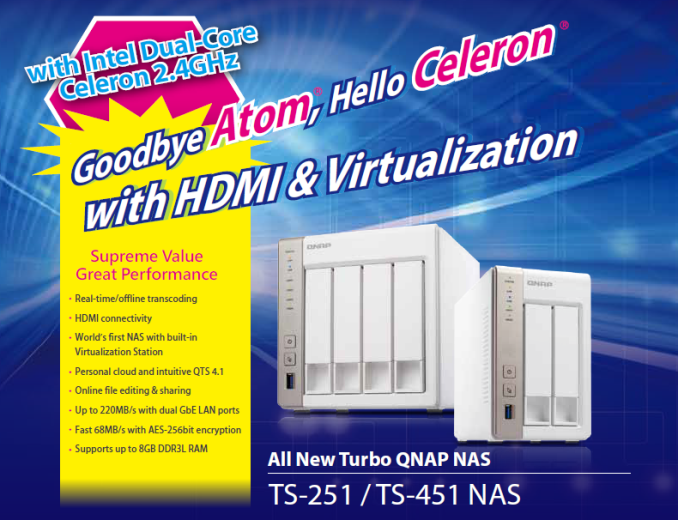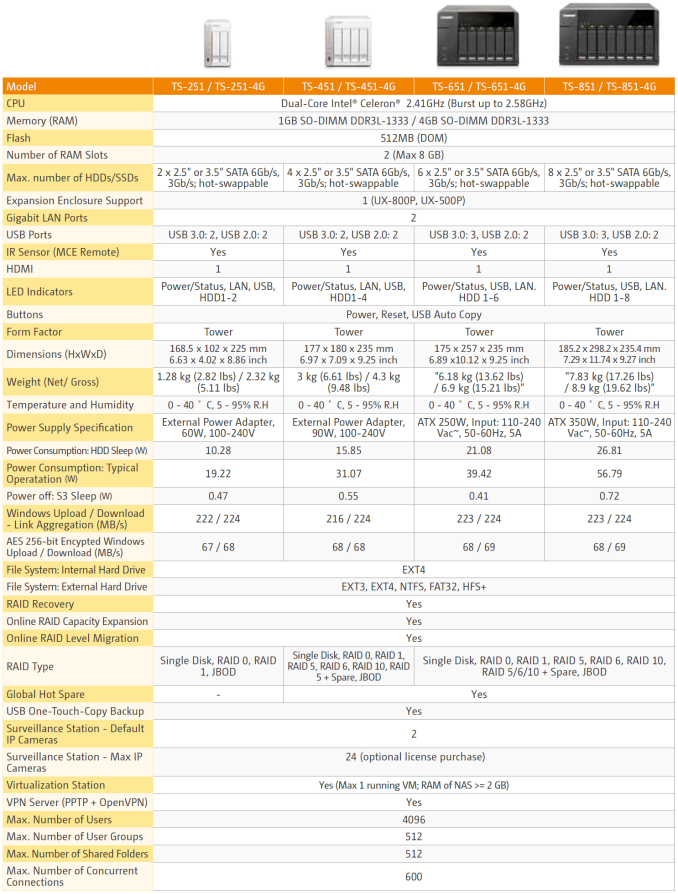QNAP TS-x51 NAS Series: Intel Quick Sync Gets its Killer App
by Ganesh T S on June 22, 2014 6:45 PM EST
Introduction
At Computex 2014, we visited QNAP and came away with a lot of information (some of which we had already seen at CES). After Computex, QNAP got in touch with me to better explain the various features of the newly introduced TS-x51 series (which was not at CES). And, boy, was I floored?! Usually, you don't see me getting very excited over product announcements. They usually get a small write-up with analysis in our pipeline section. However, I believe that QNAP's TS-x51 family has the capability to revolutionize the NAS market for home users and media enthusiasts, particularly in the way it utilizes Intel Quick Sync technology. It also gives us an opportunity to understand the state of the market and where it is headed.
The consumer / SOHO / SMB NAS market (which, in our definition, is comprised of units costing less than $5K) has two major platform vendors. In the cost-sensitive low power / performance segment, we have Marvell, with its ARM-based SoCs. Units requiring higher processing power (where cost is not a primary factor) have typically utilized Intel's x86 platforms. Over the last year or so, the delineation has been blurring quite a bit. Marvell's ARMADA 370 is no slouch when it comes to CPU performance, and it integrates a healthy number of PCIe and SATA lanes. On the other hand, Intel realized that its Bonnell-based D525 and D27xx-based solutions for the NAS market (which required an additional PCH) were not particularly power or cost efficient. While announcing its Silvermont architecture last year, Intel mentioned that the Bonnell follow-up would be part of multiple SoCs for microservers (Avoton) as well as other infrastructure equipment (Rangeley). It was widely expected that NAS vendors would move to Silvermont soon for their x86-based units. We were expecting some announcements at CES, but there was really nothing new.
QNAP's TS-x51 series has been introduced into the market just as it is on the verge of a major change. The details of the various members of the TS-x51 series are provided below. The Celeron CPU mentioned in the first row happens to be the J1800.
Before analyzing the product line and its features, let us take a short detour to understand Intel's play in this market.











49 Comments
View All Comments
ganeshts - Tuesday, July 1, 2014 - link
Yes, I have done it and it works.mannyvel - Tuesday, July 1, 2014 - link
How did your PC reconstruct the RAID? Did you have to match the RAID driver versions on your linux box/pc with your nas?Do you have a blog post/etc on your steps/process?
ganeshts - Wednesday, July 2, 2014 - link
Use UFS Explorer. I have a RAID-1 example here:http://www.anandtech.com/show/4510/lg-n2a2-nas-rev...
UFS Explorer will show you the volume as-is and does the heavy lifting of RAID reconstruction. I am not sure what you mean by RAID driver version, as these are all just software RAID, nothing proprietary involved - standard EXT4 file system with mdadm.
I will try to write a post on RAID-5 rebuild sometime in the near future.
mannyvel - Wednesday, July 2, 2014 - link
Oh, what you're saying is they're using the standard linux LVM-based md-raid, not a hardware raid implementation - which is why UFS Explorer works.GreenThumb - Monday, June 23, 2014 - link
snakyjake>> 4) Upgradability. I can't afford to keep purchasing a new complete system. And what about new vendor software?good point - does QNAP charge for software updates to the same hardware?
ganeshts - Monday, June 23, 2014 - link
Nope.. They haven't charged till now (and none of their competitors in this market segment have that practice, either). Obviously, don't know about the future.bsd228 - Monday, June 23, 2014 - link
These prosumer NAS units have made tremendous strides in the past 2 years, so I'll agree that for the disinterested, the DIY route makes less and less sense. But for those that care, it's as strong as ever. Haswell brought us 10W processors that can do everything Atom could, but 10x faster. For virtualization wishes, or background conversions of dvds/blurays to more highly compressed mp4s, this is essential, but with it sitting idle most of the time, 80W units were wasteful, hot, noisy.The key failing still present in this QNAP series is the lack of ECC memory. My HP Microservers have that that for 4 generations, as well as the ability to run numerous VMs (OS dependent - I use solaris). It was until the Gen8s stuck with a poor AMD processor and still isn't where I'd like it to be. So my next one will be truly DIY, not a nearly turnkey microserver.
Shadowmaster625 - Thursday, June 26, 2014 - link
Single pass transcoding is a joke. You're talking 3 times the file size for the same quality vs a properly configured two pass encoding. What is the point of doing that? The file is still going to end up being way to big.